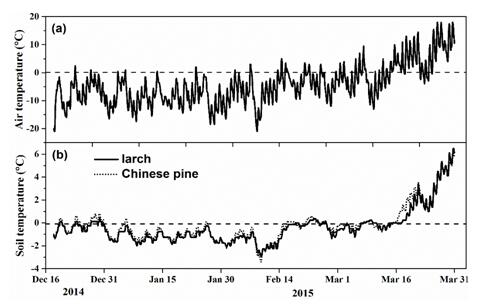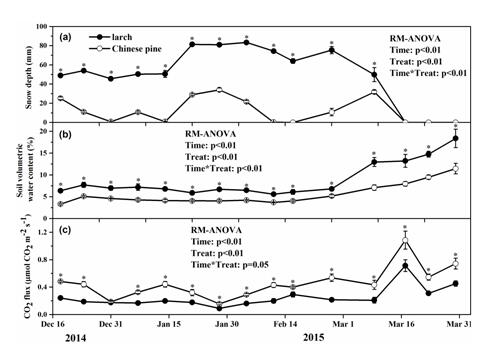Winter soil respiration composes 3-50% of annual carbon release, plays an important role in the C budget. Temperate forest ecosystem is the biggest C sink in north hemisphere, makes up 10% of global C storage.
China has 69,33 million hectares plantation which is 36% of the whole forest area . The soil respiration may be affected by the global climate change.
Prof BAI E and PhD student GAO Decai in the research group of Bio-Geo Chemistry, IAE investigated the winter soil respiration in Pinus tabuliformis plantation and Larix gmelinii Plantation. In the winter of 2014-2015, they measured the soil temperature, humidity, nutrition, soil microbial biomass, analyzed the structure and compositions of microbial community and soil extra-cell enzyme activities so as to learn the difference between the 2 plantations and related mechanisms.
The results show that the winter soil respiration rate is different. The difference is resulted from that the soil under Pinus tabuliformis plantation has higher soil microbial biomass, fungus richness, fungus/bacterium ratio and soil enzyme activities than that under Larix gmelinii plantation. The difference in snow pack thickness and in-organic Nitrogen pay no part in the differential soil respiration rate. It was found that the isolation effect of litter is important, especially in the region with snow-pack thickness less than 30 cm. Obvious, the soil microbe is more important than soil nutrition in determining the winter soil respiration rate. This means that the microbial factor should be considered in estimation of C budget in different forest ecosystems.
The results were published in the top forestry journal Forest Ecology and Management, entitled as Different Winter Soil Respiration between Two Temperate Plantation Forests. The work was supported by Youth 973 project and NNSFC.


Email: yueqian@iae.ac.cn
Publication Name:GAO Decai et al.